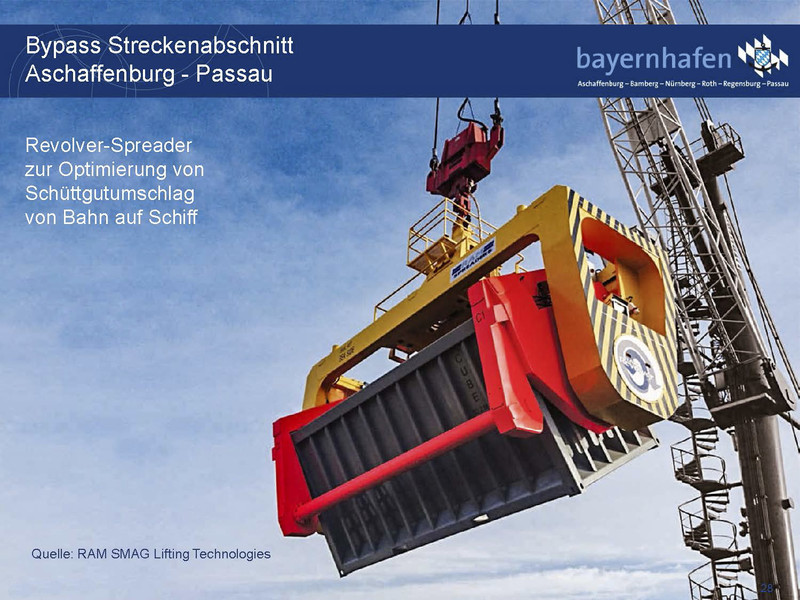29 October 2018 | bayernhafen
Breathing new life into transport solutions
2nd Bavarian Inland Waterway Shippers’ Day

During the 2nd Bavarian Inland Waterway Shippers’ Day, bayernhafen presented a new, more flexible approach to handling ship cargo in the event of changes in water levels: bulk containers that can be emptied automatically through horizontal rotation. Pictured: a RAM SMAG revolver spreader for optimising rail-to-ship bulk goods handling. (Picture: RAM SMAG Lifting Technologies)
At the ‘2nd Bavarian Inland Waterway Shippers’ Day’ in Schweinfurt, Klaus Hohberger, member of the Management Board of Bayernhafen GmbH & Co. KG, presented the new opportunities offered by high-performance hubs for linking transport solutions. In his speech, he drew on real-life examples of how the advantages of rail (speed) and shipping (price) can be developed into an integrated transport concept that mitigates limiting factors.
He explained how, from Passau travelling west on the Danube in a precisely coordinated circulation system, both the full unloading capacity of ships and the speed of rail can be linked into one highly efficient transport unit. Particularly in the light of the low water-level issue on the Danube, this enables interesting and reliable alternatives to be offered along the route. A key element of these new opportunities is the considerable leap forward made in the development of handling technology. bayernhafen has achieved this, for example, not only through new crane facilities offering lifting capacities of 120 t and the development of an automated landing stage, but also through automated warehouses that, similar to a transit station, efficiently link rail, road and inland waterway.
Hohberger demonstrated a completely new approach to increasing the flexibility in the loading of cargo onto ships in the event of changes in water level through the use of bulk-goods containers that can be emptied automatically through horizontal rotation. ‘Excess loads’ offloaded as a result of low water levels or due to conflicting waterway-class depth standards can be stored in a compact and weather-protected manner, in mixed load combinations, and forwarded using different transport modes, e.g. by rail. At a suitable point, it is then possible to quickly and economically reverse-load from rail to ship. This will be particularly interesting when the construction work on the Main to increase its unloading depth to 3.10 metres as far as Aschaffenburg is completed and the port takes on a new role as a hub port. “We don’t have to simply sit back and put up with the current restrictive conditions on the waterways. Investment in new technological solutions can also breathe new life into traditional transport solutions,” he says.
The invitation to the 2nd Bavarian Inland Waterway Shippers’ Day’ came from the German Waterways and Shipping Association Rhein-Main-Donau e.V. (DWSV) in cooperation with the Chamber of Industry and Commerce of Würzburg-Schweinfurt. In a series of presentations, industrial shippers and logistics service providers talked about the requirements and their practical experiences, and shared their perspectives and the limits facing the transportation of cargo on the waterways (Main, Main-Danube Canal, Danube). Dr. Fraas, Chairman of the DWSV, highlighted the transport of Siemens AG transformers as a successful example of heavy-lift transport by inland waterway. In his talk, Stefan Strobel, Commercial Manager of Siemens AG Transformer Plant in Nuremberg, presented the transport of record-breaking transformers from Nuremberg to China.
Detailed information and further comments on the event can be found in the DWSV’s press release (in German):
